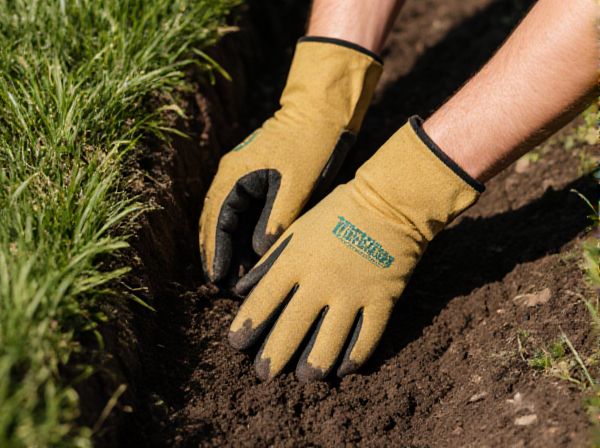
swale digging vs raised beds Illustration
Swale digging in permaculture captures and slows rainwater, promoting deep soil moisture retention and reducing erosion. Raised beds improve soil drainage, increase aeration, and allow for better root growth in compacted or poor-quality soils. Choosing between swales and raised beds depends on landscape slope, water availability, and specific plant needs within your permaculture design.
Table of Comparison
| Feature | Swale Digging | Raised Beds |
|---|---|---|
| Purpose | Water retention and soil erosion control | Enhanced soil drainage and root growth |
| Soil Management | Preserves natural soil layers | Allows custom soil mixing and amendments |
| Water Efficiency | Captures and stores rainwater on-site | Improves drainage; may require irrigation |
| Installation Effort | Labor-intensive digging and shaping | Moderate; building frames and filling soil |
| Best Use | Sloped land and erosion-prone areas | Urban gardens and poor-quality soil |
| Longevity | Long-term; minimal maintenance | May require periodic soil replenishment |
| Plant Diversity | Supports deep-rooted, water-loving plants | Flexible; supports wide range of crops |
Introduction to Swale Digging and Raised Beds
Swale digging involves creating shallow trenches on contour lines to capture and infiltrate rainwater, reducing erosion and promoting groundwater recharge in permaculture systems. Raised beds, by contrast, elevate the soil level above ground to improve drainage, soil structure, and root growth while facilitating efficient space use and crop rotation. Both techniques enhance soil health and water management but serve distinct roles in permaculture design, with swales focusing on landscape-scale water retention and raised beds optimizing growing conditions at a more localized level.
Understanding Swale Systems in Permaculture
Swale digging in permaculture involves creating contour-aligned trenches that capture and infiltrate rainwater, enhancing soil moisture and reducing erosion on sloped land. Raised beds, while effective for soil control and accessibility, do not manage water flow across the landscape as efficiently as swales. Understanding swale systems is crucial for optimizing water retention, supporting diverse plant growth, and improving overall ecosystem resilience in permaculture design.
Key Benefits of Swale Digging for Water Management
Swale digging enhances water management by capturing and directing rainfall to reduce runoff and soil erosion, promoting efficient water infiltration into the ground. This technique supports soil hydration, cultivates healthier plant growth, and maintains groundwater levels essential for sustainable permaculture systems. Compared to raised beds, swales create microclimates and improve landscape resilience by managing water distribution across slopes and uneven terrain.
Raised Beds: Design and Functionality
Raised beds enhance soil drainage by elevating planting areas, preventing waterlogging and root rot common in flat or swale-adjacent soils. Their modular design improves soil structure through controlled compost addition and reduces soil compaction from foot traffic. This optimized environment supports diverse crop growth and efficient nutrient cycling, making raised beds a sustainable choice for intensifying food production in permaculture systems.
Soil Health: Swales vs Raised Beds
Swale digging enhances soil health by promoting water infiltration and reducing erosion, which supports microbial activity and nutrient retention in the soil profile. Raised beds improve soil structure and drainage by providing loose, aerated soil, preventing compaction and facilitating root growth. Both methods contribute to soil vitality but swales focus on landscape-scale water management, while raised beds optimize localized soil conditions for plant development.
Plant Selection and Crop Yield Comparison
Swale digging improves water retention and soil fertility, enabling the cultivation of drought-tolerant and deep-rooted plants, while raised beds offer enhanced soil control suited for shallow-rooted crops like leafy greens and herbs. Crop yield in swales tends to be higher for fruit trees and perennials due to consistent moisture, whereas raised beds usually produce faster, more reliable yields for seasonal vegetables. Selecting plants according to these growing conditions maximizes productivity and ecological benefits in permaculture systems.
Climate Suitability: When to Choose Swales or Raised Beds
Swale digging excels in arid or semi-arid climates by capturing and retaining rainwater on contour lines, preventing soil erosion and enhancing groundwater recharge. Raised beds are ideal in wetter or colder regions with poor drainage, as they improve soil aeration and warmth, enabling extended growing seasons. Selecting the appropriate technique depends on local precipitation patterns, soil type, and topography to maximize water efficiency and crop productivity.
Maintenance Requirements: Swales vs Raised Beds
Swale digging requires ongoing maintenance to manage water flow and prevent erosion, including periodic reshaping and clearing of debris. Raised beds demand consistent soil amendment and irrigation monitoring to maintain fertility and moisture levels, minimizing weed growth. Both methods benefit from mulch application, but swales generally involve more landscape-scale upkeep compared to the localized attention raised beds need.
Cost Analysis and Resource Investment
Swale digging requires substantial initial labor and machinery costs due to earthmoving and contour assessment, but offers long-term water retention benefits that reduce irrigation expenses. Raised beds involve lower upfront construction costs with materials like wood or stone but may increase ongoing water and soil amendment expenditures. Comparing resource investment, swales optimize landscape-level water management, while raised beds demand continuous input for soil fertility and moisture maintenance.
Choosing the Best Approach for Your Permaculture Garden
Swale digging enhances water retention and soil erosion control by creating contour trenches that capture and distribute rainwater efficiently in permaculture gardens. Raised beds improve soil aeration and drainage, offering better root growth and easier maintenance in varied soil conditions. Selecting between swales and raised beds depends on site topography, climate, and specific water management needs to optimize garden sustainability and productivity.
swale digging vs raised beds Infographic

 gardendif.com
gardendif.com